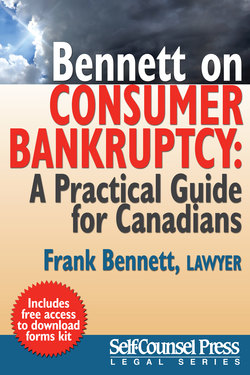Читать книгу Bennett on Consumer Bankruptcy - Frank Bennett - Страница 19
На сайте Литреса книга снята с продажи.
2. Different Types of Creditors
ОглавлениеUnder the Bankruptcy and Insolvency Act, there are three general types of creditors.
First, there are secured creditors. Secured creditors are types of creditors that hold some form of property as security for the payment of a debt. For example, if a bank holds a mortgage over the debtor’s home, the mortgage document creates the security against the home. The consumer debtor cannot sell or transfer the home without paying the bank. If the debtor fails to pay monthly, or fails to pay taxes or other amounts under the mortgage, the bank has the right to foreclose, that is to become the owner, or the bank has the right to sell the home to pay the debt. If the bank does not sell the home for enough money to cover the mortgage debt, then the bank has a shortfall and the amount of that shortfall is an unsecured claim in the bankruptcy.
Consider this example: The Dominion Bank holds a mortgage against the debtor’s home for $200,000. There are no other mortgages against the debtor’s home. If the debtor defaults in making monthly payments to the bank, the bank has a right through legal process to take the debtor’s home and eventually sell it. If the bank realizes $160,000 towards the $200,000 loan, then $40,000 is the shortfall or deficiency. The bank then has an unsecured claim for the $40,000. However, if the bank sells the home for $240,000, the bank has a $40,000 surplus, and the debtor is entitled to that money. If the debtor were bankrupt for other debts, the trustee would intercept the $40,000.
Second, there are the preferred creditors. These are certain types of creditors that are specifically recognized under the Bankruptcy and Insolvency Act. There are several different types including wage earners, claims under support orders, municipalities for business taxes, and landlords of commercial premises. They receive a preferred place if there is a distribution of monies from the sale of the debtor’s assets. Preferred creditors are reviewed in Chapter 5.
Last, there are ordinary unsecured creditors. These are creditors who do not hold any of the property of the debtor as security for the debt and they are not given any priority or preferred standing in the administration. One example might be a mobile phone service provider. They have no special rights against the debtor or against his or her property. Creditors who obtain judgment against the debtor are also in this group.
